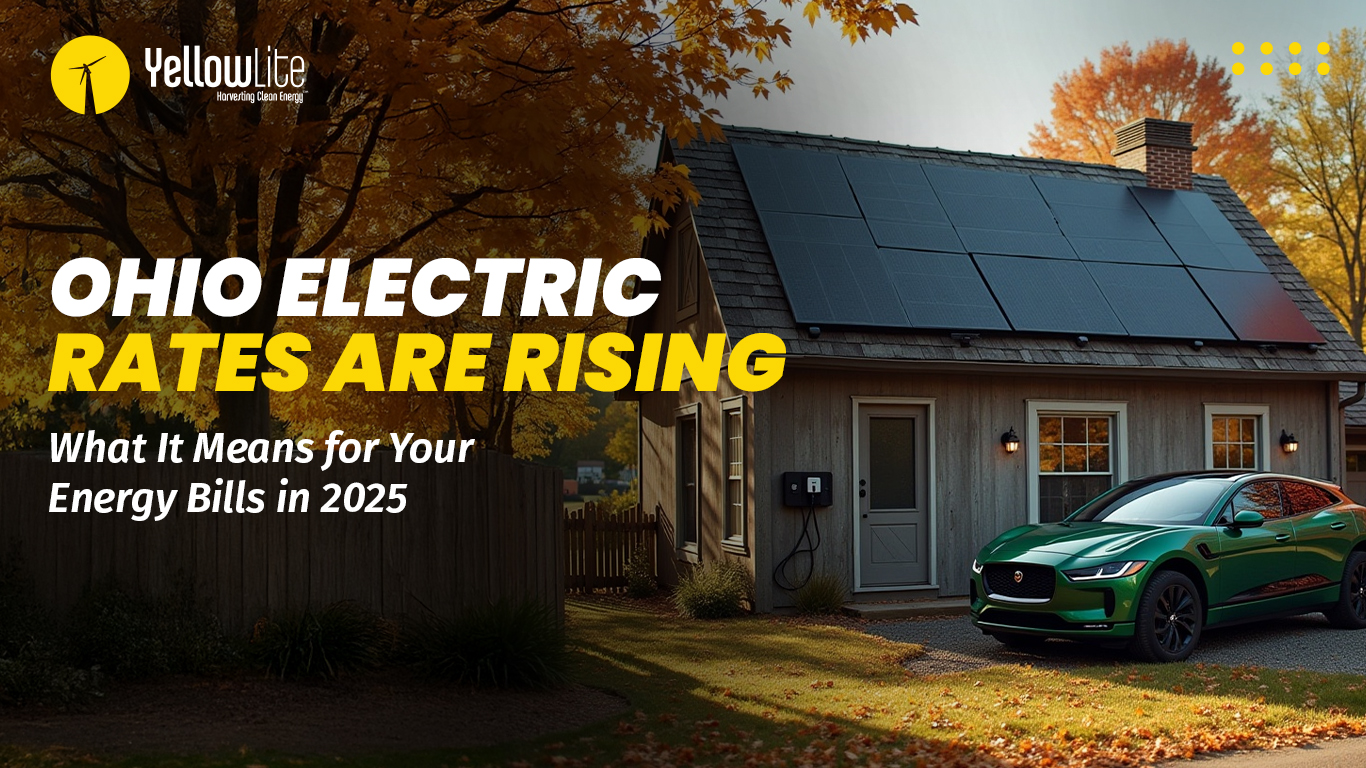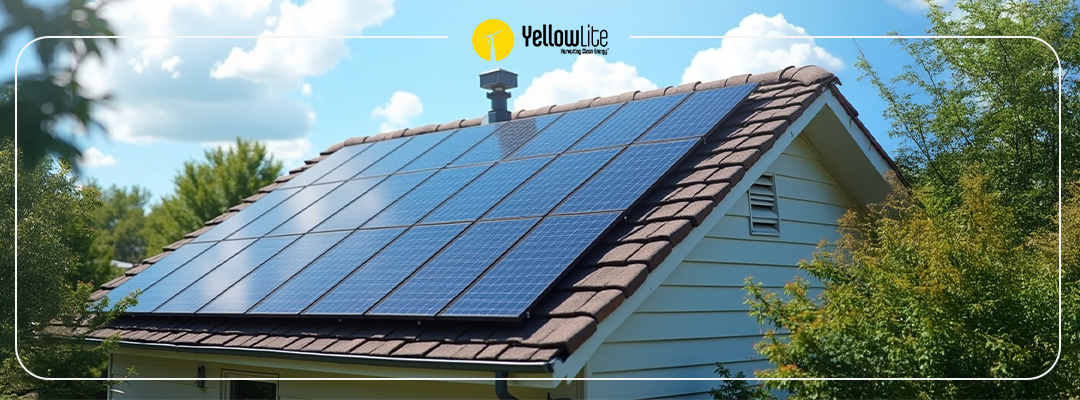Total Emission Elimination: Powering Electric Vehicles with Solar Energy
In a previous YellowLite post, we examined the true environmental cost of charging an electric car via the traditional power grid in the state of Ohio. A brief recap: the Chevy Volt requires 45 kilowatt-hours (kWh) of energy to travel 100 miles and the production of that electricity in Ohio would result in around 78 pounds of CO2 being emitted into the atmosphere. As a comparison, a gasoline-powered car that averages 25 MPG will also emit 78 pounds of CO2 into the atmosphere.
Ohio has a heavy reliance on coal for electricity generation. This means that more CO2 is emitted per kWh of energy produced than in other states since burning coal produces more CO2 per unit of energy than burning petroleum or natural gas. Nevertheless, I still found this result quite surprising. It prompts the question: if electric vehicles are powered by electricity burned from coal, are they really that much better for the environment?
Let's attempt to answer this question by looking at it through the prism of renewable energy. Would using a rooftop solar power system to charge an electric car eliminate associated emissions entirely? The answer is yes. So now, the question becomes, “can a household solar system produce enough electricity to accommodate a common daily commute in an electric vehicle and how big of a system would we need?”
Basic Calculations
In order to provide an easy way for the reader to determine what size home solar system is needed to produce the amount of energy required to operate an electric vehicle (EV), a great deal of simplification has been employed in the following calculation. First, a number of factors that affect the energy output of a solar array will average out over the course of the year including shading, temperature, and seasonal variations in sunshine. We will look at the macro numbers to see how much energy a medium-sized solar array produces and compare this to how much energy an electric vehicle uses on a daily basis.
We will use the following two equations to estimate those quantities:
Solar Array Energy Output per Day = Average Daily Hours of Sunshine * Size of System * Inverter Efficiency
Energy Consumed by Vehicle = Miles Driven per Day * Energy Used per Mile
Explanation of Terms
Power Rating of Panel - Ratings for various panels are shown on the EnergySage website. The typical solar panel will be between 200 to 350 watts. At YellowLite we prefer to recommend a well-respected high efficiency brand such as SunPower. In general, we will determine an average-sized panel to be 250 Watts (0.25 kW). So four panels will equate to 1kW.
Average Daily Hours of Sunshine - Ohio averages around 4.2 hours of full sunshine per day over the course of the year. Data for the entire U.S. can be found at the National Renewable Energy Laboratory website.
Size of System - A medium-sized array would be 5kW, or right around 20 panels (250 watts per panel x 20 panels = 5,000 watts or 5kW. The typical panel is generally at least 5 feet by 3 feet or 15 square feet in coverage area. 20 panels would cover around 300 square feet of space.
Inverter Efficiency - An inverter converts the DC power generated from the solar panel to AC power that is used by the devices in the house. While inverters continue to improve, there are still energy losses due to electricity being changed during the DC to AC conversion, typically around 5-15%. In this case, we will derate the system by 10% and assume inverter efficiency of 90%.
Miles Driven Per Day - The average annual miles traveled per driver in Ohio is 12,906. If we divide this by 365 we get an average of 35.4 miles per day. The data used in this report is available on the Federal Highway Administration’s website.
Energy Used Per Mile - The standard for reporting the efficiency of EV’s is often cited in terms of number of kWh per 100 miles. We will use an average value of 32 kWh/100 miles (or 0.32kWh/mile). This figure is derived from the average efficiency of the 2016 electric vehicle models of the Ford Focus and Nissan Leaf. More data can be found on the fueleconomy.gov website.
Crunching The Numbers
Using the equations above, we insert our estimate values to approximate the energy production of our model solar array and the electrical consumption of our model vehicle.
Solar Energy Production:
4.2 kWh of Sunshine x 5kW Array x 90% Inverter Efficiency = 18.9 kWh of Electricity produced per day
Vehicle Energy Consumption:
35.4 Miles Driven Per Day x 0.32 kWh Per Mile = 11.31 kWh of Electricity Consumed Per Day
If we divide 18.9kWh produced by a Medium-sized solar array by 11.3 kWh consumed by a typical electric vehicle we get a number equal to 1.67 electric vehicles that could be powered. Or, another way of looking at this is a solar array can fully cover the energy needs of an electric vehicle per year and still contribute to lowering the household's electricity bill. Or still another way of looking at this is that a 3kW array would be enough to offset the environmental impact in full of driving an electric vehicle.
If the average vehicle in the country gets 25.5 mpg, then over the course of a year based on Ohio's average driver mileage of 12,906, electric vehicle drivers will save the cost of filling up at the pump by foregoing 506 gallons of gas. Gas is currently listed at $2.22 a gallon in the state of Ohio. This means that over a full year of going solar and driving electric, you would save over $1,100. Not bad.
Wrap-Up
The calculation provided above was intended to give the reader a ballpark estimate for a household solar panel system energy production and an EV’s energy consumption. As indicated earlier, every value that was used was an average. If you are interested in personalizing the calculation for your own system/vehicle, follow the links provided for more detailed data. The average solar panel cost has gone down by a tremendous amount over the last six years and solar panel costs are now at an all-time low.
To get an estimate on a solar array call us today at 1-877-743-8757 or email us at info@yellowlite.com. Ask about our special discount for all electric and hybrid car owners. Ask us what are the best solar panels for your house. Sign and then save $1,000.

Interested in learning more about YellowLite’s renewable energy solutions? Reach out to us today to learn more.



